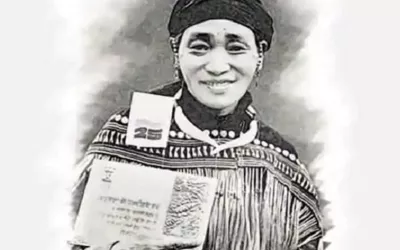Rani Gaidinliu joined Heraka movement
The Heraka was a socio-religious movement derived from ancestral Naga practices known as "Paupaise". It was established by Jadonang Malangmei, popularly known as Haipou Jadonang. He was a political and spiritual Naga leader from Manipur, British India. The movement was formed when Jadonang saw the growing influence of Christianity in the Naga territory. He considered it a threat to the traditional religion of the Nagas. As a result, Jadonang constructed Heraka temples called "Kao Kai". The Heraka movement has been variously described as a religious reform movement, a cult, and the "Naga renaissance". The movement was widespread in the Zeliangrong territory.
The Heraka movement faced opposition from the newly converted Christian Nagas. Earlier in 1930, four Manipur traders had been murdered in Jadonang's native village Puiluan. Jinlakpou – one of the first Christian converts of Tamenglong – informed the Government about the murders and alleged that Jadonang had ordered these murders. Jadonang stated that the decision to kill the traders had been taken by the whole village, not just him. On 13 June 1931, Jadonang was declared guilty of the murders at a trial by the British authorities. He was hanged to death on 29 August 1931 at 6 am. After the execution of Jadonang, his cousin Rani Gaidinliu, led the movement.
Tribal people's conversion to Christianity in Manipur
Reverend William Pettigrew was the first foreign missionary to arrive in Manipur. As per records, he was arrived on 6 February 1894. He converted the first non-Christian named Angom Porom Singh to Christianity in Manipur. Since then, a gradual rise in the Christian conversion of local Manipuri people has started. However, several reports claimed that enticement, superstitions and fraudulent ways had been used by Christian missionaries to convert the tribal people in Manipur.
Percentage of Christians in Manipur by decades
Source: cpsindia.org
Percentage of Christians in the Scheduled Tribes
Source: cpsindia.org
Rani Gaidinliu and Christianity
Rani Gaidinliu decisively resisted the conversion of Nagas to Christianity. Rani Gaidinliu promoted the Heraka faith within the community to protect it from fraudulent conversion to Christianity. Gaidinliu described the aim of the movement as, “to reform old religious practices in order to strengthen the movement aimed at ousting the British.” She came to be considered an incarnation of the Goddess Cherachamdinliu. At age of 17, she valiantly led many guerilla forces to fight against the British and became a target for the British forces. She openly rebelled against British rule. She persuaded the Zeliangrong people not to pay taxes and not cooperate with the British. They united as one and refused to assist the British, which led to several repressive measures imposed by the police and Assam Rifles, such as collective fines on the villagers. As a result, on October 17, 1932, the British forces launched a surprise attack and arrested the Gaidinliu. She was taken to Kohima on foot and later to Imphal for a trial. She was convicted on charges of murder and abetment of murder and was sentenced to life imprisonment. Most of her close associates were either executed or jailed. Rani Gaidinliu was released after the Interim Government of India was set up in 1946. She continued to work for the upliftment of her people after her release. Gaidinliu was opposed to the Naga National Council (NNC) insurgents, who advocated secessionism from India. The Christians perceived the Heraka revival movement as anti-Christian.
Awards and death
However, upon criticism, Gaidinliu was awarded the Tamrapatra Freedom Fighter Award in 1972, the Padma Bhushan (1982) and the Vivekananda Seva Award (1983). Posthumously, she was also conferred the Birsa Munda Award, and the Government of India issued a postal stamp in her honour in 1996. Additionally, in 2015, the Government of India also issued a commemorative coin in her honour. She died on 17 February 1993 at the age of 78.













Comments
Add new comment